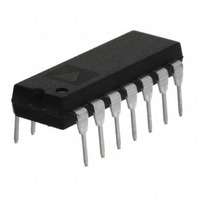ADVFC32KN Analog Devices Inc, ADVFC32KN Datasheet - Page 4

ADVFC32KN
Manufacturer Part Number
ADVFC32KN
Description
IC CONV V/F F/V 0-70DEGC 14-DIP
Manufacturer
Analog Devices Inc
Type
Volt to Freq & Freq to Voltr
Datasheet
1.ADVFC32KNZ.pdf
(6 pages)
Specifications of ADVFC32KN
Mounting Type
Through Hole
Rohs Status
RoHS non-compliant
Frequency - Max
500kHz
Full Scale
±75ppm/°C
Linearity
±0.05%
Package / Case
14-DIP (0.300", 7.62mm)
Frequency
0.5GHz
Linearity %
0.000005%
Digital Ic Case Style
DIP
No. Of Pins
14
Converter Type
Frequency/Voltage + Voltage/Frequency
Converter Function
VFC/FVC
Full Scale Frequency
500
Power Supply Requirement
Dual
Single Supply Voltage (typ)
Not RequiredV
Single Supply Voltage (max)
Not RequiredV
Single Supply Voltage (min)
Not RequiredV
Dual Supply Voltage (typ)
±15V
Dual Supply Voltage (min)
±9V
Dual Supply Voltage (max)
±18V
Operating Temperature (min)
0C
Operating Temperature (max)
70C
Operating Temperature Classification
Commercial
Package Type
PDIP
Lead Free Status / Rohs Status
Not Compliant
Available stocks
Company
Part Number
Manufacturer
Quantity
Price
Company:
Part Number:
ADVFC32KN
Manufacturer:
AD
Quantity:
5 510
Part Number:
ADVFC32KN
Manufacturer:
ADI/亚德诺
Quantity:
20 000
Company:
Part Number:
ADVFC32KNZ
Manufacturer:
AD
Quantity:
450
Part Number:
ADVFC32KNZ
Manufacturer:
ADI/亚德诺
Quantity:
20 000
ADVFC32
Input resistance R
variable resistor (R3) to allow for initial gain error compensation.
To cover all possible situations, R3 should be 20% of R
R1 should be 90% of R
to compensate for the ADVFC32 full-scale error and the toler-
ance of C1.
If more accurate initial offset is required, the circuit of R4 and
R5 can be added. R5 can have a value between 10 kΩ and
100 kΩ, and R4 should be approximately 10 MΩ. The amount
of current required to trim zero offset will be relatively small, so
the temperature coefficients of these resistors are not critical. If
large offsets are added using this circuit, temperature drift of
both of these resistors is much more important.
BIPOLAR V/F
By adding another resistor from Pin 1 (Pin 2 of TO-100 can) to
a stable positive voltage, the ADVFC32 can be operated with a
bipolar input voltage. For example, an 80 kΩ resistor to 10 V
causes an additional current of 0.125 mA to flow into the inte-
grator so that the net current flow to the integrator is positive
even for negative input voltages. At negative full-scale input
voltage, 0.125 mA will flow into the integrator from V
ling out the 0.125 mA from the offset resistor, resulting in an
output frequency of zero. At positive full scale, the sum of the
two currents will be 0.25 mA and the output will be at its maxi-
mum frequency.
UNIPOLAR V/F, NEGATIVE INPUT VOLTAGE
Figure 3 shows the connection diagram for V/F conversion of
negative input voltages. In this configuration full-scale output
frequency occurs at negative full-scale input, and zero output
frequency corresponds to zero input voltage.
A very high impedance signal source may be used since it only
drive the noninverting integrator input. Typical input imped-
ance at this terminal is 250 MΩ or higher. For V/F conversion
of positive input signals the signal generator must be able to
source 0.25 mA to properly drive the ADVFC32, but for nega-
tive V/F conversion the 0.25 mA integration current is drawn
from ground through R1 and R3.
Circuit operation for negative input voltages is very similar to
positive input unipolar conversion described in the previous
section. For best operating results use component equations
listed in that section.
IN
is composed of a fixed resistor (R1) and a
IN
. This allows a ± 10% gain adjustment
IN
IN
cancel-
, and
F/V CONVERSION
Although the mathematics of F/V conversion can be very com-
plex, the basic principle is easy to understand. Figure 4 shows
the connection diagram for F/V conversion with TTL input
logic levels. Each time the input signal crosses the comparator
threshold going negative, the one shot is activated and switches
1 mA into the integrator input for a measured time period
(determined by C1). As the frequency increases, the amount of
charge injected into the integration capacitor increases propor-
tionately. The voltage across the integration capacitor is stabilized
when the leakage current through R1 and R3 equals the average
current being switched into the integrator. The net result of
these two effects is an average output voltage which is propor-
tional to the input frequency. Optimum performance can be
obtained by selecting components using the same guidelines and
equations listed in the V/F conversion section.
DECOUPLING
Decoupling power supplies at the device is good practice in any
system, but absolutely imperative in high resolution applica-
tions. For the ADVFC32, it is important to remember where
the voltage transients and ground currents flow. For example,
the current drawn through the output pull-down transistor
originates from the logic supply, and is directed to ground
through Pin 11 (Pin 8 of TO-100). Therefore, the logic supply
should be decoupled near the ADVFC32 to provide a low im-
pedance return path for switching transients. Also, if there is a
separate digital ground it should be connected to the analog
ground at the ADVFC32. This will prevent ground offsets that
could be created by directing the full 8 mA output current into
the analog ground, and subsequently back to the logic supply.
Although some circuits may operate satisfactorily with the power
supplies decoupled at only one location on each board, this
practice is not recommended for the ADVFC32. For best results,
each supply should be decoupled with 0.1 µF capacitor at the
ADVFC32. In addition, a larger board level decoupling capaci-
tor of 1 µF to 10 µF should be located relatively close to the
ADVFC32 on each power supply.
COMPONENT TEMPERATURE COEFFICIENTS
The drift specifications of the ADVFC32 do not include tem-
perature effects of any of the supporting resistors or capacitors.
The drift of the input resistors R1 and R3 and the timing capaci-
tor C1 directly affect the overall temperature stability. In the








